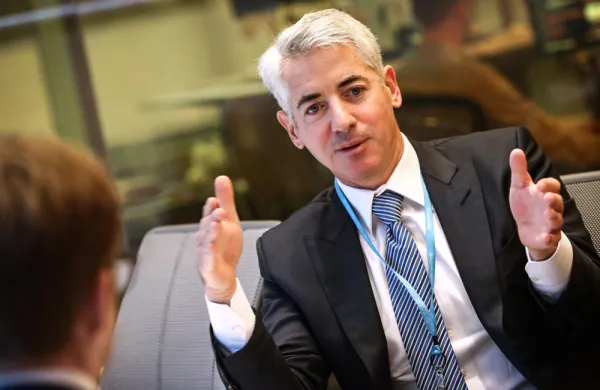The first task for the new head of Goldman Sachs Asset Management, one of the world’s biggest money managers, with $873 billion under management, will be stabilizing the business after an extremely rough 2007. GSAM has been battered not only by terrible investment performance by its quantitative team but also by turnover among its top executives. Last November, Edward Forst, formerly chief administrative officer of Goldman, Sachs & Co. and the highest-ranked official of the bank outside the U.S., was named co-head of GSAM with Peter Kraus. Forst took the place of former GSAM co-head Eric Schwartz, who stepped down in July. Then this March, Kraus also resigned, leaving Forst alone at the top to deal with the very large jobs of improving returns and soothing restive customers.
The poor returns by the quantitative team are taking a toll on growth. Net revenues for the asset management division were $4.49 billion in 2007, 5 percent higher than in 2006 but hurt by an 80.6 percent drop in GSAM’s performance fees, to $187 million for the year. (Goldman doesn’t report earnings separately for the asset management unit.)
GSAM’s performance fees improved to $194 million in this year’s first quarter from $90 million in the same period last year. Good news, of course, but still down dramatically from the $739 million in performance fees in the first quarter of 2006, a bumper year largely because of the almost 40 percent return of the Global Alpha fund in 2005.
A real blow: GSAM reported net outflows of $17 billion from equity funds in the first quarter of this year. Among the losses: The Massachusetts Pension Reserves Investment Board, which terminated a $1.2 billion enhanced equity mandate in February. MassPRIM confirmed the move but declined further comment.
“That’s a concern,” says Standard & Poor’s analyst Scott Sprinzen of the outflows. “It’s the first time we’ve seen these kind of outflows at GSAM in the last couple of years.”
Goldman did better in fixed-income funds, which saw new inflows of $2 billion during the first quarter of this year. But these funds are low-fee and less lucrative than equity assets. “During periods of market turbulence, it is not uncommon to see a movement out of equity funds into fixed-income funds and money market funds,” says a spokeswoman for Goldman in an e-mail. Meanwhile, low-fee money market funds saw inflows of $46 billion in the first quarter of 2008, compared to inflows of $11 billion in the same period last year.
To be sure, other quantitative firms, like Barclays Global Investors and State Street Global Advisors, have struggled lately. But GSAM’s problems in its quantitative division struck at one of the firm’s main growth engines in recent years.
To address this problem, Goldman Sachs is restructuring GSAM’s quantitative team, which manages about $200 billion in assets. According to a memo sent to clients in December, Robert Jones will no longer be head of the quant equity team. Jones, who had run the group for nearly 20 years, was replaced by Mark Carhart, who is also keeping his job as co-head of the quant strategies group.
The quantitative group took a big hit when its highest-profile hedge fund, Global Alpha, fell almost 40 percent last year and similar, but lower-risk, global tactical asset allocation portfolios also suffered losses. Goldman, however, still managed to raise about $7 billion for a new long-short equity hedge fund launched in January, proof of the power of its brand.
When Forst took the title of head of GSAM in March, Stephen Fitzgerald, head of GSAM’s European and Asia business, shifted to become co-head of Goldman’s investment banking division in his native Australia. He will be replaced by Suzanne Donohoe, former head of distribution for GSAM in the U.S., according to a Goldman spokeswoman. Donohoe was also the highly regarded head of GSAM in Europe from 2001 to 2006, a period of high growth for the firm in the region, and is therefore well suited to the job.
Forst, a Harvard University graduate who grew up on Chicago’s South Side, joined Goldman Sachs in 1994 from Bankers Trust Co., where he was head of U.S. loan sales and trading. A former chief of staff for Goldman’s equities division, he was appointed chief administrative officer of the firm in February 2004. Forst, 47, was not available to talk about his plans.
But he has a formidable task ahead. First, he will have to reassure GSAM customers. A European pension
fund manager who recently closed a $1 billion global tactical asset allocation portfolio at GSAM says, “To keep the mandate running in rough times, we need to feel this is a top priority for management, and they haven’t been able to convince us this is the case.” The fund closed its three-year contract with GSAM at a loss, this manager says. In an e-mail a GSAM spokeswoman says, “Our No. 1 priority is serving clients, and we are very concerned if a client is disappointed.”
Meanwhile, in an August letter to its client the California Public Employees’ Retirement System, Wilshire Consultants said it was “closely watching” the performance of an enhanced equity mandate run by GSAM for the giant pension fund. CalPERS did renew GSAM’s contract for one year, however. Goldman Sachs’ enhanced U.S. equities mandate lost 12.4 percent versus the -0.1 percent return of its custom benchmark in the year ended December, according to CalPERS’s latest quarterly review. A CalPERS spokesman declined comment.
Although changes at GSAM had been expected after the hedge fund blowups, those changes could work against the group in the short term, say pension fund managers. “Institutional investors don’t like management changes,” notes Geoffrey Bobroff, president of Bobroff Consulting, a fund consulting firm in Rhode Island. “They tend to be concerned about what other changes may follow.”





